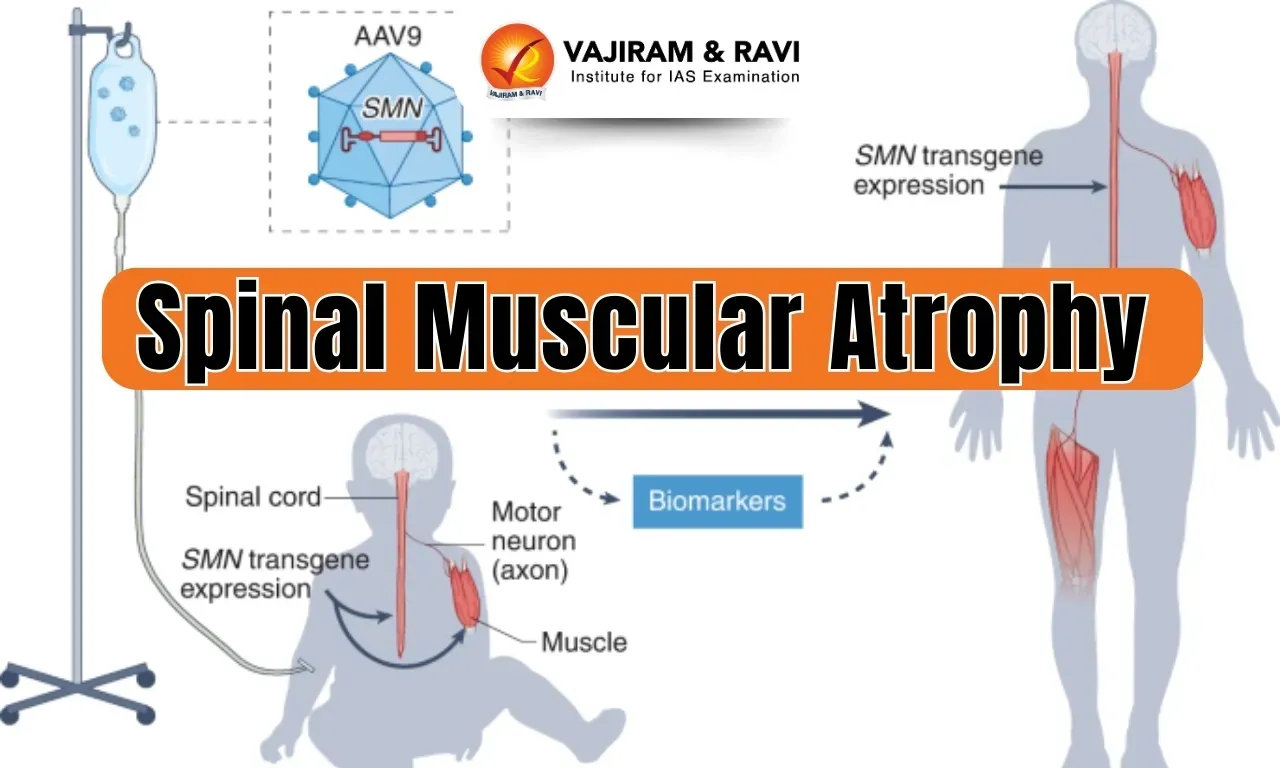Spinal Muscular Atrophy Latest News
Recently, clinical neuroscientists said that they have managed to treat a deadly motor neuron disease spinal muscular atrophy (SMA) in a baby who was still in the womb.
About Spinal Muscular Atrophy
- It is a debilitating genetic condition which affects motor neurons that control movement, and leads to progressive muscle weakening.
- Types of SMA: There are five subtypes of SMA- type 0, 1, 2, 3, 4. Healthcare providers classify them based on the age of onset, as well as the severity and life expectancy.
Symptoms of Spinal Muscular Atrophy
- Its symptoms vary and may be mild or disabling, but involve a weakness of the muscles that control movement. Involuntary muscles are not affected, such as those in the heart, blood vessels and digestive tract.
- The weakness in SMA tends to be more severe in the muscles that are close to the center of your body than in the muscles farther away from your body’s center.
Causes of Spinal Muscular Atrophy
- The condition is caused by mutations in the survival motor neuron gene (SMN1) which causes a deficiency of a protein crucial for the survival of motor neurons in the spinal cord.
- Prevalence: About one in every 10,000 births have some form of the condition making it a leading genetic cause of death in infants and children.
Symptom Management Therapies of Spinal Muscular Atrophy May Include
- Unfortunately, there isn’t a cure for SMA. Treatment for SMA mainly seeks to manage symptoms and prevent complications.
- Physical therapy, which can help improve posture, prevent joint immobility and slow muscle weakness.
- Between 2016 and 2020, the U.S. Food and Drug Administration (FDA) approved treatments that can significantly improve the course of SMA. They include: Disease-modifying therapy and Gene replacement therapy.
Spinal Muscular Atrophy FAQs
Q1. What is spinal muscular atrophy?
Ans. Spinal muscular atrophy (SMA) is a disorder affecting the motor neurons—nerve cells that control voluntary muscle movement.
Q2. What are the early signs of spinal muscular atrophy?
Ans. Early signs are limited movement, can’t sit without support, and have trouble breathing, feeding, and swallowing.
Q3. What is the difference between muscular dystrophy and spinal muscular atrophy?
Ans. In SMA, the motor neurons that serve the muscles that are located in the spinal cord are destroyed. In MD, the damage is often occurring to the muscle fibers themselves.
Source: IE
Last updated on June, 2025
→ UPSC Notification 2025 was released on 22nd January 2025.
→ UPSC Prelims Result 2025 is out now for the CSE held on 25 May 2025.
→ UPSC Prelims Question Paper 2025 and Unofficial Prelims Answer Key 2025 are available now.
→ UPSC Calendar 2026 is released on 15th May, 2025.
→ The UPSC Vacancy 2025 were released 1129, out of which 979 were for UPSC CSE and remaining 150 are for UPSC IFoS.
→ UPSC Mains 2025 will be conducted on 22nd August 2025.
→ UPSC Prelims 2026 will be conducted on 24th May, 2026 & UPSC Mains 2026 will be conducted on 21st August 2026.
→ The UPSC Selection Process is of 3 stages-Prelims, Mains and Interview.
→ UPSC Result 2024 is released with latest UPSC Marksheet 2024. Check Now!
→ UPSC Toppers List 2024 is released now. Shakti Dubey is UPSC AIR 1 2024 Topper.
→ Also check Best IAS Coaching in Delhi
























